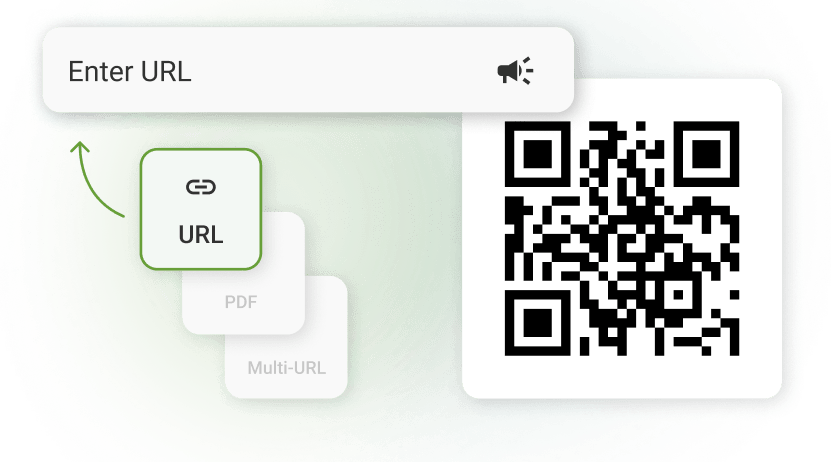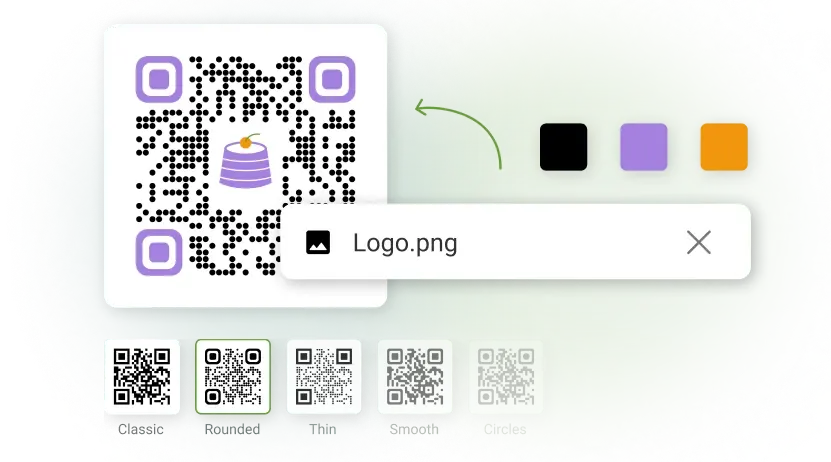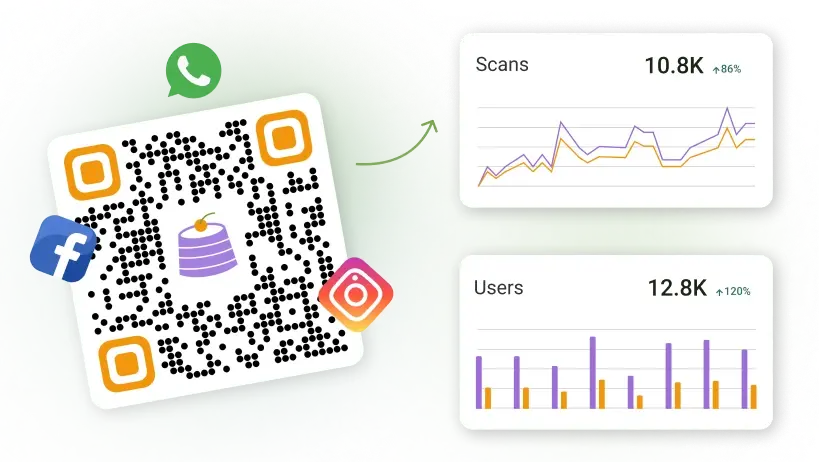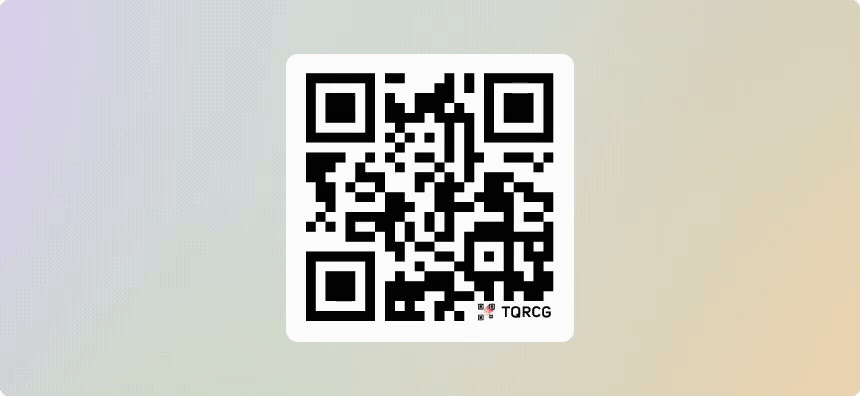Most QR Codes look the same. Monochrome blocks, bland, and no hint of what brand they belong to. But what if that same QR Code could carry your logo, reflect your brand’s visual identity, and actually get more scans?
Branded QR Codes aren’t just prettier; they’re more effective. However, logos must be used properly on your QR Code pattern to retain scannability. The design should strike a balance between aesthetics and functionality.
Let’s explore why this small design change makes such a big difference.
What are some benefits of using logos in QR Codes?
Standard QR Codes may appear generic and monochrome, leading users to overlook them. On the other hand, QR Codes with logos are visually distinct, brand-aligned, and designed to drive action.

QR Codes with logos visually represent your business at every touchpoint. From packaging to posters, they help your audience recognize, trust, and remember your brand instantly.
Below are the key benefits of using logo-enhanced QR Codes beyond just aesthetics.
1. Enhanced brand identity
Embedding your logo directly into the QR Code reinforces brand consistency. Whether placed on a product label, digital ad, or business card, the code instantly signals who it belongs to, strengthening visual identity across all platforms.
2. Increased scan rates
Branded QR Codes attract more attention. A well-designed code with your logo stands out, looks trustworthy, and encourages interaction, especially compared to a plain version that users might hesitate to scan.
3. Professional appearance
A logo QR Code signals attention to detail. It shows your brand is intentional about every customer interaction. This level of presentation builds credibility and adds polish, especially in client-facing or high-stakes contexts like events and packaging.
4. Memorable marketing tool
When your QR Code includes a recognizable brand element, it becomes easier for people to recall the interaction later. This boosts long-term engagement and makes your campaigns more effective over time.
Let’s explore how to create a custom QR Code with a logo that looks great and performs reliably.
How do you make a QR Code with a logo?
Follow these steps to create a QR Code with a logo.
Step 1: Choose an appropriate QR Code generator
Use a trusted platform like The QR Code Generator (TQRCG). Look for one that supports live preview, dynamic codes, logo upload, and scan reliability metrics.
Step 2: Pick the content type

Decide what the QR Code will link to: URL, text, vCard, file download, Wi-Fi access, or a social profile.
For example, paste the link in the given space if it’s a URL. Your QR Code will appear on the right-hand side of the screen.
Step 3: Upload your logo
Click the color palette option below the QR Code. A customizable window will appear on your screen where you can change the QR Code style, colors, and outer margin. To include a personalized logo, you can sign up for a 15-day free trial.

Once you sign up, upload a high-resolution image file (PNG or SVG works best). TQRCG’s tool will automatically detect and resize the file format as needed.
Step 4: Customize the design
Choose colors that match your brand, but maintain high contrast between the pattern and background.
- Change the colors if needed.
- Experiment with rounded or soft-corner styles.
Step 5: Adjust logo settings
Ensure the logo is correctly placed and scaled. The most common placement is at the center, but a subtle corner one works for minimalistic designs. TQRCG auto-optimizes this based on the QR Code’s layout.
Step 6: Test for scannability
Use multiple devices (iOS and Android) and QR Code apps to test. TQRCG shows you a live scan score before you download.
Step 7: Export and use
Download in PNG for the web, SVG for scaling, or PDF for print, and you’re good to go.
Does the logo size on the QR Code matter?
The logo size on the QR Code directly impacts whether your QR Code can be scanned. QR Codes use error correction to tolerate some distortion or missing data. The higher the error correction level (L, M, Q, or H), the more damage or obstruction the code can withstand. Logos that cover too much of the code reduce the scanner’s ability to detect essential data.
The ideal size: The logo should cover no more than 20% of the QR Code’s area. Any more, and you risk scan failures unless your QR Code is generated with optimized settings.
Where can you use custom QR Codes with logos?
You can use custom QR Codes with logos on product packaging, business cards, posters, event tickets, menus, brochures, and digital ads. They’re great for engaging people with your brand, especially in customer-facing or high-traffic touchpoints.
Here are some examples:
1. Marketing campaigns
BrewBound, a small coffee brand, ran a guerrilla marketing campaign featuring branded installations with their logo and QR Codes. Visitors who scanned the QR Code were directed to the brand’s website and social media, and the campaign encouraged social sharing with a branded hashtag. This approach increased brand awareness and customer engagement.
Also, coffee shops can now use BonusQR, a loyalty app that employs QR Codes (often branded with the shop’s logo) to enroll customers in rewards programs. Customers scan the QR Code at the counter to join and track rewards, boosting engagement and repeat business.
2. Business cards
Professionals are embedding QR Codes with their logos on business cards. These codes can link to portfolios, LinkedIn profiles, or contact information. Customization options allow for personal branding, including logo placement and color schemes.
3. Product packaging
Major beauty brands like L’Oréal, Clinique, and Vaseline are integrating QR Codes (often with brand logos) on product packaging. These codes link consumers to tutorials, verified reviews, and loyalty programs, deepening customer engagement and trust.
4. Event tickets
Organizers of concerts and festivals use QR Codes for ticketing and entry. These QR Codes are often customized with event logos and colors, enhancing the event’s branding and providing a premium feel while streamlining check-in and operations.
5. Restaurant menus and payments
Over half of the surveyed restaurants use logo-branded QR Codes for digital menus, and nearly all use some form of customization. These codes help diners recognize the brand and trust the digital experience. Restaurants also use QR Codes for payments, making the process faster and more convenient for customers while reinforcing the brand identity.
Create logo QR Codes with TQRCG
The right logo size, clever placement, and attention to detail can differentiate a successful scan from a missed opportunity. Platforms like TQRCG make this easier by adjusting logo size dynamically and giving you real-time scannability feedback.
If you’re using QR Codes, take the extra minute to brand them properly. Your brand deserves to be recognized at a glance, even in a small square of code.
Frequently asked questions
The logo may have covered too much code or lacked enough contrast. Use a tool like TQRCG to check scan quality before publishing.
PNG and SVG provide crisp quality. JPG is usable, but less ideal for scaling.
Absolutely. Just make sure your print resolution is 300 DPI or higher.
Yes. Use high-contrast colors for readability. Avoid light-on-light combinations.
Yes. Clear space ensures your logo doesn’t interfere with the QR Code’s structure.
Many free tools offer logo support, but premium tools like TQRCG provide added features such as real-time scan scoring and auto-optimization.
Yes, if done right. Adding a logo increases the chance of someone trusting and scanning your code. For small and local businesses, a recognizable brand element like a logo is often the deciding factor between being scanned or ignored. It also helps build memory.
There are two types of QR Codes in which you can insert logos:
a. Static QR Codes: Once created, the content is locked. Such QR Codes are typically suitable for permanent URLs or printed materials.
b. Dynamic QR Codes: The content can be updated later per requirements. Dynamic QR Codes are ideal for campaigns, A/B testing, and analytics.










 No credit card required
No credit card required
